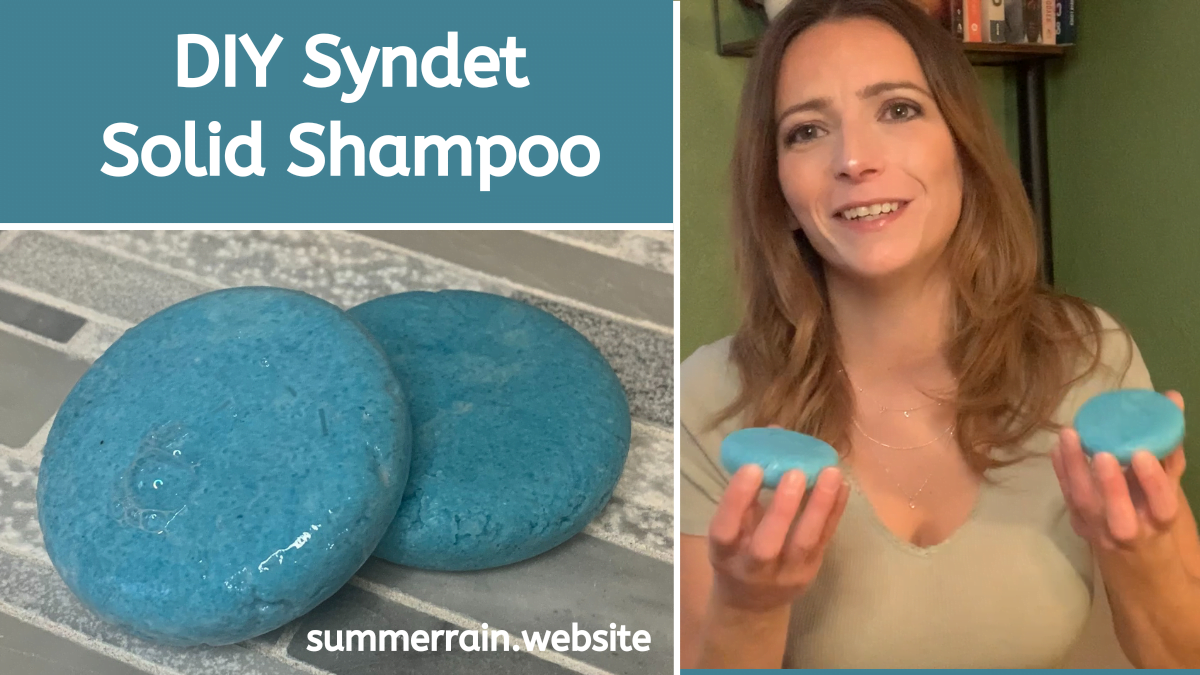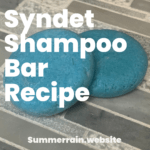A Syndet Bar (also known as a Solid Shampoo Bar) is a blend of ingredients that gives you a shampoo in dry form. It has surfactants that will pull the dirt and grease from your hair and cleans it. This recipe does not use any lye.
If you want to learn how to make a shampoo bar like Lush? You have come to the right place. Syndet bars have gained popularity because you do not need any plastic packaging and they are easy to travel with.
Table of Contents
Prefer to watch this project instead of reading it?
Some of the links are affiliate links, because I am an associate and I earn a small commission on them.
Syndet bars vs Soap Bars
The word Syndet is a combination of the words “synthetic” and “detergent” the first three letters from each make up the word SYN-DET. It is the combination of surfactants, which are able to surround dirt and oil and remove them with water. This is because the surfactants have on end that loves water and one that repeals water. The surfactant will grab dirt and oil and surround it. Then the other end of the surfactant that loves water will grab the water and rinse down the drain.
Looking at a syndet bar one major advantage over a soap bar is that it has a lower pH. This allows you to add things to your shampoo bar that might be sensitive to pH levels.
The word syndet can be confusing. We use this term because it is not technically soap. These types of bars are often called “beauty bars”, “cleansing bars” and “soap free”. If you pay attention at the stores, a lot of the soap that we buy is not actually “soap”.
Why would you want a syndet bar?
True soap is make with vegetable oils and lye. As discussed, the pH level of these syndet bars is much lower than what you can get with soap. These bars are typically better for your hair than a true soap would be. Using a soap that has a high pH on your hair can actually cause damage. A high pH can cause dull hair, tangling and matting of your hair.
Benefits of Syndet Bars
- Ease of travel
- Easy to make
- Low pH
- Gentle on hair
How are Syndet bars made?
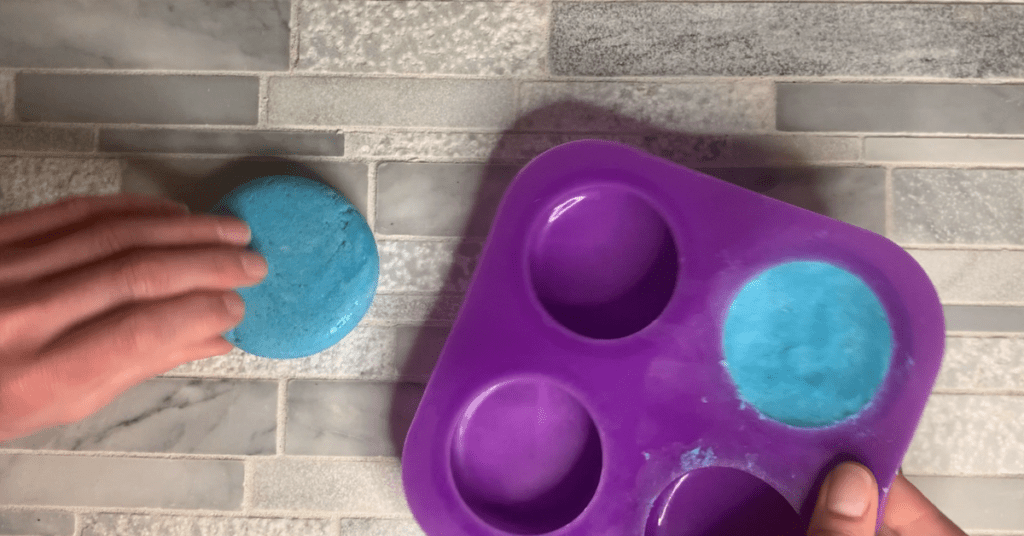
Surfactants are going to be the main ingredient in a syndet shampoo bar. Surfactants are what is going to be the cleaning agent in this shampoo. For a WAY more in depth description on surfactants check out Surfactants Explained post.
What is a Syndet bar?
Shampoo bars are a solid blend of surfactants (cleansers) that are used to clean our hair. Shampoo bars are in solid form, like a bar of soap. However, they are not technically “soap” because they are made with a blend of surfactants not through mixing oils and lye.
What is the most commonly used surfactant in syndet bars?
Sodium Cocoyl Isethionate
Sodium Cocoyl Isethionate is a gentle surfactant that is derived from coconut. It is tolerant of hard water.
You can get Sodium Cocoyl Isethionate in a noodle or powder form. I strongly recommend getting the powder form. If you get it in noodle form, you will have to put it through a grinder to get it to a fine powder. You are going to want to mask up for this as the powder will get in the air and irritate your lungs.
Sodium Lauryl Sulfoacetate – SLSa
Sodium Lauryl Sulfoacetate is a gentle natural surfactant that has great foaming properties. This surfactant os derived from plants and it creates a lovely lather to removes surface oil, dirt and bacteria, without stripping or drying sensitive skin.
Cocamidopropyl Betaine
Cocamidopropyl Betaine is an amphoteric surfactant with a pH of 5-6. It is mild and compatible with anionic, cationic and nonionic surfactants. Using this with other surfactants helps to increase the foam and increases effectiveness of non-ionic surfactants.
What makes a shampoo bar hard?
We are going to use hardeners and thickeners to keep our shampoo bar in solid form. (in addition to all of the power surfactants that we already went over).
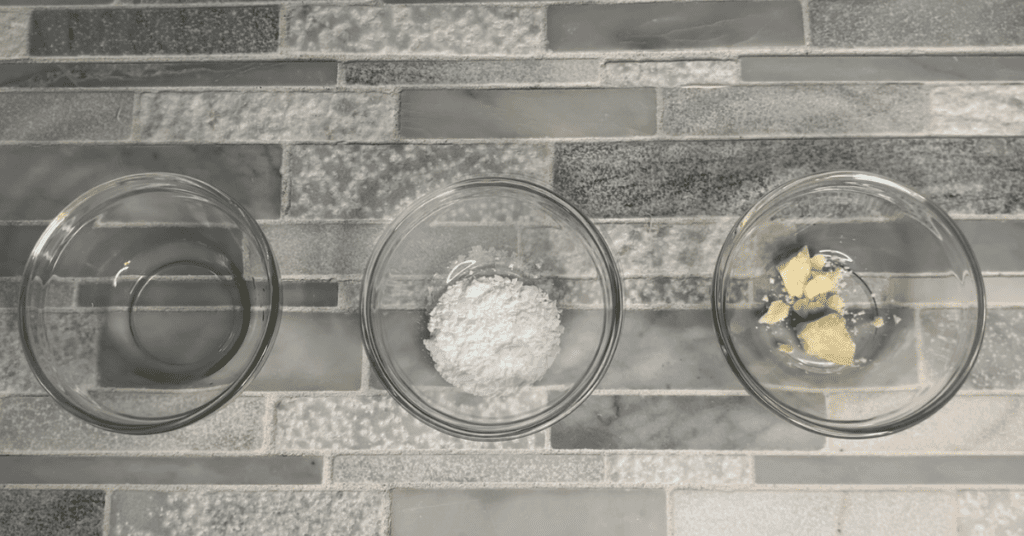
Sodium Lactate
Sodium lactate is basically a liquid salt that is used to help to harden our shampoo bars. It comes from the fermentation of corn and beet sugars. It is also a wonderful humectant that will help to draw moisture into your hair.
Cocoa Butter
Cocoa butter is an emollient that helps to soften and nourish our hair. I like that the cocoa butter adds the lightest hint of a chocolate aroma and that it helps to harden it up a little bit.
Ceytl Alcohol
Although cetyl alcohol has ‘alcohol’ in the name, it is not drying to the skin. We normally assume that all alcohols would have a drying effect. In contrast, cetyl alcohol is very hydrating to our skin. It is also a conditioning agent in this shampoo bar.
Do you need a preservative in shampoo bars?
You are probably thinking that because that shampoo bar does not contain any water, you can get away with not using a preservative. Technically, that is true, However, you are going to be contaminating the outside of the shampoo bar with water when you use it, so it is a good idea to use a preservative. I am using Germall Plus in this syndet bar.
Heat Sensitive Ingredients
We have a cool down phase, this is going to be all of the ingredients that are heat sensitive. Typically this phase will include fragrance oil, essential oils and preservatives. We have to wait to add these ingredients until the temperature is lower. If they are added when the Solid Shampoo Bar is too hot, it can break down the ingredients and make them less effective.
What pH should shampoo bars be?
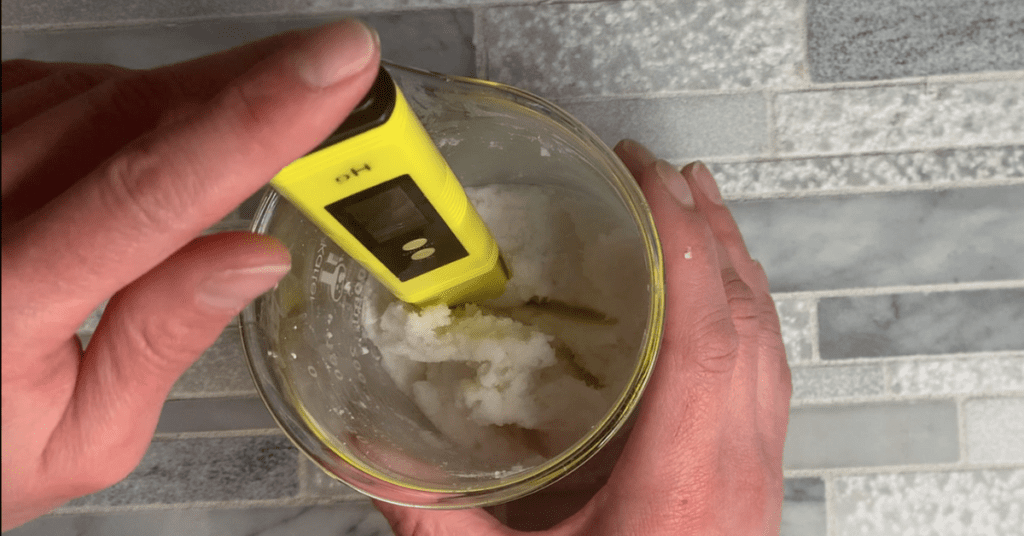
The pH range that you want for a syndet shampoo bar is between 4-5.5.
pH in hair care is important because having it too high can cause cuticle damage, frizz, irritation and hair breakage.
To lower the pH of the shampoo bar a bit, I add in a 50% citric acid solution that I made.
How do you keep Syndet shampoo bars from getting mushy?
You will want to place your shampoo bar in a place where it will not be sitting in a pool of water.
I recommend using a draining soap dish.
How to use a Syndet Shampoo Bar?
Wet your hair in the tub or shower. You are going to use the shampoo bar just like you would a bar of soap. Start out by lathering the bar up in your hands. Once you have a lather worked up, spread it in your wet hair.
Apply mostly to the scalp and avoid the ends of your hair. Massage your scalp with your fingertips for a few minutes. Rinse and repeat until you feel that your hair is cleaned.
How do you make a shampoo bar harder?
Allow the shampoo bar to sit out for 24-48 hours to allow some of the water from the liquid ingredients to evaporate.
For the first few hours, the bar will be soft enough to press a thumbprint in but the next day it will be solid. If you find that your bar is not getting hard enough you can add some sodium lactate at up to 5% to harden them.
Customizing your Syndet Bar Recipe
The cool thing about making your own solid shampoo bars is that each one can be tailored to your needs by making small changes to the ingredients.
Moisturizing shampoo
These are going to contain emollients, like butters and esters.
Conditioning shampoo
These are going to contain a positively charged (ionic) ingredient that increases shine and reduces tangles.
Hydrolyzed Wheat Protein
You can add a bit of Hydrolyzed Wheat Protein as it helps with softening and repairing our hair. It is said to add moisture and add volume. Some things that you can substitute the hydrolyzed wheat protein as oat protein, vegetable keratin or hydrolyzed silk.
BTMS 25
BTMS 25 is a cationic conditioning emulsifying wax. It gives our final product a luxurious creamy consistency. It also brings in hair softening and detangling properties to the shampoo bar.
French Green Clay
The French Green Clay is what is going to give these shampoo bars their color. The color of the clay actually comes from decomposed plant material in the clay. It contains calcium, iron, magnesium, and potassium.
Kaolin Clay
Kaolin clay is used as a thickener and to harden the shampoo bar. It is said to draw impurities from our skin.
Fragrance Oil
You do not have to add any fragrance but you can add a fragrance oil or essential oil to add a scent to your syndet bar.
Syndet Bar Recipe
Syndet Shampoo Bar Recipe
Equipment
- Scale
Ingredients
- 2.91 ounce | 48.5% Sodium Cocoyl Isethionate
- 1.86 ounce | 31% Sodium Lauryl Sulfoacetate
- 0.54 ounce | 9% Cocamidopropyl Betaine
- 0.21 ounce | 3.5% Sodium Lactate
- 0.12 ounce | 2% Cocoa Butter
- 0.12 ounce | 2% Cetyl Alcohol
- 0.03 ounce | 0.5% Germall Plus
- 0.12 ounce | 2% Fragrance Oil
- 0.09 ounce | 1.5% Hydrolyzed Wheat Protein
Instructions
- Put all of your surfactants into a mixing container.
- After you remove from the heat add the melted butter mixture in with your surfactants. Mix very slowly.
- Add sodium lactate and mix well. You may need to heat the mixture to get it to mix.
- Lower the Ph.
- Add the colorant, preservative, fragrance and Hydrolyzed Wheat Protein and mix.
- Place the mixture into your silicone mold. Be sure to press down to really pack it in.
- Unmold and enjoy!
